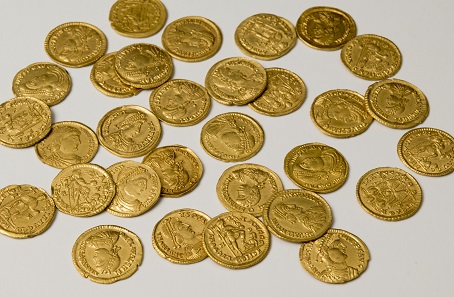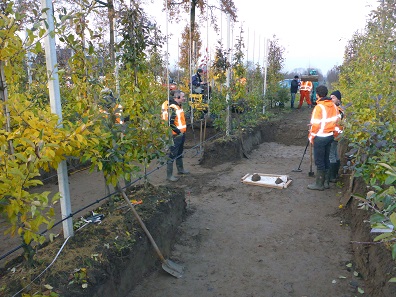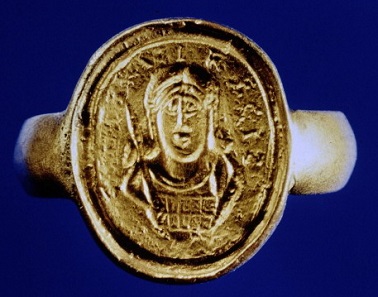by Annika Backe
July 20, 2017 – The project ‘Portable Antiquities of the Netherlands’ (PAN) had been established only the previous month when, in the summer of 2016, its staff received a very special message. A metal detectorist reported that he had found more than 20 Roman gold solidi in an orchard near Lienden in the Gelderland province. They belong to a treasure of which single pieces have shown up over the course of the years.
Solidi found between 2012 and 2016. Photo: Museum Het Valkhof, Nijmegen.
To the ones behind PAN, this constitutes a perfect debut. With the collaboration of universities, governmental institutions, museums, the Dutch Central Bank and hobby archaeologists, the project aims at documenting private archaeological finds. Detector finds play a special role, for they have been declared legal in the Dutch Heritage Act (Erfgoedwet) from July 1, 2016. The competent authorities in the Netherlands are now hoping for active participation of the general public, as exemplified by the ‘Portable Antiquities Scheme’ that was established for England and Wales 20 years ago.
Such a solidus of Marjorian is the youngest coin found in the Lienden hoard. Photo: De Nederlandsche Bank.
In their examination of the Roman gold find, the PAN specialists looked into old source material related to the find site. They found out that already in the 19th century coins had appeared in the relevant area that was leveled around 1840 to gain land for farming. An archaeological excavation was then conducted in 2016.
Archaeologists further excavate the find site in November 2016.
The campaigns didn’t add any more coins to the 41 known specimens, though. Apart from cremated remains in a ceramic vessel, the experts secured bone fragments dating from ca. 1800 BC. According to Nico Roymans, Professor of Archaeology at the Amsterdam Vrije Universiteit and head of the PAN project, the owner of the treasure might have hoped for his coins to be protected by this special place, most likely a burial mound.
Copy of a lost signet ring featuring Childeric and the inscription CHILDIRICI REGIS (‘of Childeric the King’). Photo: Gallica / Wikipedia.
Chronologically, the gold coins cover a wide range. The earliest specimen dates from the time of Emperor Valentinian II (AD 375-392) whereas the latest was minted under Emperor Majorian (AD 457-461). They are likely to have served as payment for a follower of Childeric, the Merovingian King of the Salian Franks, to assist in the fight against Germanic tribes. He may even have got it from Aegidius, the Roman General who successfully established himself as autonomous ruler, independent of the Western Roman government, in Northern Gaul by 461.
Currently on display at the Nijmegen Museum Het Valkhof, the find is of major importance to research. In an official statement, the archaeologists in charge explain: “The Lienden gold treasure is a special, unique testimony to the final stages of the Roman dominion on Dutch territory. It provides insight into the politico-military situation at the turn to early medieval times. It constitutes the latest known gold treasure in the Netherlands, also marking the end of the Western Roman Empire.”
To visit the website of the Museum Het Valkhof, please click here.
More information on the ‘Portable Antiquities of the Netherlands (PAN)’ project is available here.
The website of the English ‘Portable Antiquities Scheme’ can be accessed here.
And on Coinsweekly, you can also read about a Roman coin trove found in a Swiss cherry orchard.







